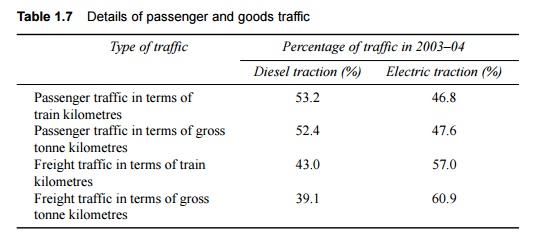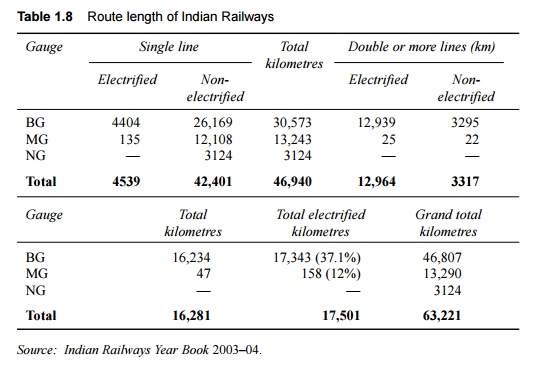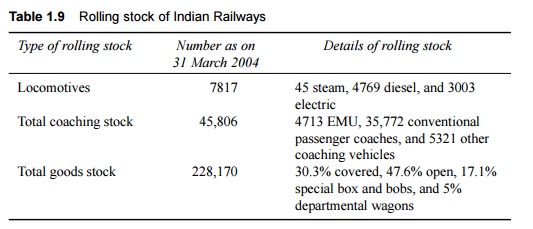Chapter: Civil : Railway Airport Harbour Engineering : Railway Engineering : History and General Features of Indian Railways
General Features of Indian Railways
General Features of Indian Railways
Indian Railway is the
second largest state-owned railway system in the world (after Russian Railways)
under unitary management. The important features of Indian Railways are
described here.
1 Track
Track or permanent way
is the single costliest asset of Indian Railways. It consists of rails,
sleepers, fittings and fastenings, ballast, and formation. Complete details of
the track are given in Chapter 5.
2 Locomotives
In
the year 2003-04, Indian Railways owned a fleet of 7817 locomotives including
45 steam locomotives, 4769 diesel locomotives, and 3003 electric locomotives.
The number of steam locomotives reached its peak in 1963-64 with 10,810 units.
It then declined gradually, as the production of steam locomotives was stopped
in 1971. Diesel and electric locomotives, which are more than twice as powerful
as steam locomotives, have progressively replaced steam locomotives. Owing to
the heavy investments involved in replacing all the existing steam locomotives
with diesel and electric locomotives, steam locomotives were gradually phased
out, and it was decided that these should be retained in service till the
expiry of their codal life or 2000 AD, whichever is earlier. Accordingly, most
steam locomotives of the Indian Railways have been phased out.
Apart from replacing
steam locomotives with diesel and electric locomotives in areas of heavy
traffic density, a large number of diesel shunting engines are also being
introduced as replacements for steam shunting locomotives. This has enabled
Indian Railways to improve operational efficiency in both passenger and freight
operations.
3 Traction
The traction mix has
significantly changed in the last two decades and Railways have been
progressively switching over to diesel and electric traction. Though steam
locomotion involves the least initial costs, it is technologically inferior to
diesel and electric traction in many respects. On the other hand, diesel and
electric locomotives have superior performance capabilities, the electric
locomotive being the more powerful one of the two. Electric traction is also
the most capital intensive and, therefore, requires a certain minimum level of
traffic density for its economic use. In broad terms, the traction policy on
Indian Railways envisages the extension of the electrification of high-density
routes as dictated by economic and resource considerations and the
dieselization of the remaining services.
The passenger and freight traffic in the
year 2003-04 in terms of train kilometres as well as gross tonne kilometres is
given in Table 1.7.
Table
1.7 Details of
passenger and goods traffic

4 Electrification and Electric Traction
Electric traction using
1500-V dc was first introduced in 1925 in a small section of the Mumbai area,
and till 1957 it was confined to less than 466 km, comprising mainly the
suburban sections of Mumbai and Chennai. Electrification on the main line sections
was, however, taken up towards the end of the second Five Year Plan using a 25
kV, single-phase ac system.
The
electrification of the Howrah-Burdwan suburban section of Kolkata on the
Eastern Railway was taken up during the first Five Year Plan (1951-56) and
completed in 1958. Thereafter, the electrification of Indian Railways has
continued in a planned manner on the trunk routes connecting the four
metropolitan cities of Kolkata, Delhi, Mumbai, and Chennai and other
high-density routes.
The electrified route
kilometres of Indian Railways constitute about 27.68% of the total route
kilometres. Out of a total of 17,500 electrified route kilometres, about 1500
are in suburban sections and the balance in heavy-density freight routes.
During 2003-04, 47 per cent of passenger kilometres and 61.3 per cent of BG
freight gross tonne kilometres were operated on electric traction.
The route length as on
31 March 2004 in each gauge, indicating double/multiple lines, single lines,
and the electrified route, is given in Table 1.8:
Table
1.8 Route length of
Indian Railways

5 Dieselization and Diesel Traction
Diesel and electric
locomotives are comparatively more efficient than steam locomotives. They
provide greater hauling capacity, have better acceleration and deceleration,
and are capable of higher speeds. They have less servicing needs, and,
therefore, their availability for traffic is comparatively more. Thus,
electrification and dieselization lead to considerable savings as well as
improvement of line capacity.
Diesel
traction started on the ex North Western Railway prior to the second world war
with the introduction of diesel shunting engines. Diesel traction got off to a
real start with the use of diesel locomotives on the newly laid MG line to
Gandhidham in 1955-56. It progressed rapidly after the introduction of the BG
main line locomotives in the heavy-density sections of the eastern region in
1958-59 to ensure speedy and adequate transportation of raw materials and
finished product to and from steel plants. Diesel traction has subsequently
been extended to other high-density routes and routes situated away from
coalfields. Today, diesel electric traction is significant in the motive power
scene in Indian Railways.
6 Rolling Stock
The fleet of the Indian Railways rolling stock is
presented in Table 1.9.
Table
1.9 Rolling stock of
Indian Railways

Indian
Railways is in the process of modernizing its rolling stock by inducting newer
designs of fuel-efficient locomotives, high-speed coaches, and modern
high-speed bogies for freight traffic. The Railways are also gradually
replacing four-wheeler stock with bogie wagons that have a higher pay loads and
speed potential for optimum utilization of line capacity. These include BCN,
BTPN, BOXN wagons, etc.
Related Topics